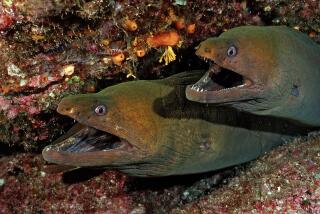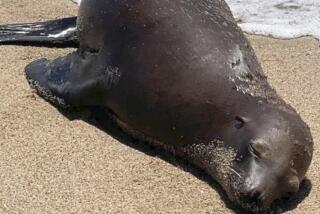Dead Gray Whale Washes Onto San Clemente Beach
SAN CLEMENTE â A 35-foot dead California gray whale washed ashore on a beach here Wednesday, drawing a crowd of onlookers who braved the rain to watch as scientists sliced off its head, winched it on a truck and transported it to the Natural History Museum in Los Angeles.
âItâs a sad feeling that makes me want to cry,â said Linda Cognito, a Capistrano Beach resident who rushed to see the mammal at Prima Deshecha Canada Beach, which is between Dana Pointâs exclusive Beach Road homes and San Clementeâs Capistrano Shores mobile park, near the intersection of Coast Highway and Camino Capistrano.
âTheyâre almost like human beings,â she said.
John Heyning, assistant curator at the museum, said it was the first whale to wash up in the region during the annual migration of gray whales from Baja California to Alaska.
âItâs really emaciated,â Heyning said, pointing to the visible rib cage of the 12-ton mammal.
Museum officials said the adult whale apparently died of natural causes. Officials of the Orange County Marine Institute speculated that the mammal could be the same one that caused a stir Tuesday when it swam into the mouth of nearby Dana Point Harbor for several hours.
âItâs difficult to say, but itâs a reasonable assumption,â said Harry Helling, associate director of the Dana Point institute. âYou donât get many of them swimming so close to the beach.â
Heyning said the whale should normally have weighed 8 tons more than its estimated 12 tons. Heyning noted that whales do not feed much while migrating but also said an illness could have caused the mammal to stop eating altogether.
Institute officials rushed to the area to see whether the whale was still alive after an unidentified Capistrano Beach resident reported sighting it near the surf line.
A handful of nearby residents also turned out to see the mammal. The heavy surf pounded the leviathan as it lay on the sands, making the tons of blubber roll like dark Jell-O.
The surf, however, did not deter San Clemente resident Richard Pearson from walking up to the mammal and placing his ear against its stomach, as if to check for a heartbeat.
âThereâs certainly no sound coming from it,â said Pearson, 42. âToo bad. . . . We could have tried to tow it back if itâ was alive.
Other onlookers posed for pictures in front of the carcass.
After the high tides subsided, Heyning and his assistants set about to take specimens. Museum assistant Tom Lewis carved deep holes in its flesh to remove live barnacles and sea lice that clung to its sides.
The most difficult task, however, was beheading it--which scientists commonly do to study dead whales. Lewis sank a flensing knife into the top of the head. A steady stream of blood spewed out, creating a crimson stretch several hundred yards along the surf line.
âWhat a day at the beach!â Lewis said, shivering. âBut it would have been a lot more difficult if this whale had eatenâ and been bigger.
Later, a small San Clemente city tractor lifted the whaleâs head to make it easier to remove.
Heyning and other scientists will use the specimens to determine how the whale died. City workers were expected to bury the remains late Wednesday.
More to Read
Sign up for Essential California
The most important California stories and recommendations in your inbox every morning.
You may occasionally receive promotional content from the Los Angeles Times.










